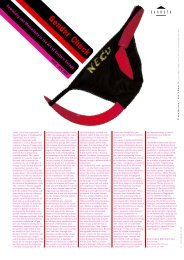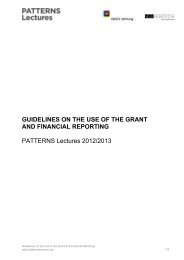DIE ERSTE österreichische Spar-Casse ... - ERSTE Stiftung
DIE ERSTE österreichische Spar-Casse ... - ERSTE Stiftung
DIE ERSTE österreichische Spar-Casse ... - ERSTE Stiftung
Create successful ePaper yourself
Turn your PDF publications into a flip-book with our unique Google optimized e-Paper software.
Holders of Fixed Rate Notes are exposed to the risk that the price of such Notes falls<br />
as a result of changes in the market interest rate<br />
Holders of Fixed Rate Notes are exposed to the risk that the price of such Notes may fall as a<br />
result of changes in the market interest rate. While the nominal interest rate of Fixed Rate<br />
Notes as specified in the Final Terms is fixed during the life of such Notes, the current interest<br />
rate on the capital market for issues of the same maturity typically changes on a daily basis.<br />
As the market interest rate changes, the price of Fixed Rate Notes also changes, but usually<br />
in the opposite direction. If the market interest rate increases, the price of Fixed Rate Notes<br />
typically falls until the yield of such Notes is approximately equal to the market interest rate. If<br />
the market interest rate falls, the price of Fixed Rate Notes typically increases until the yield of<br />
such Notes is approximately equal to the market interest rate.<br />
If the holder of Fixed Rate Notes holds such Notes until maturity, changes in the market<br />
interest rate are without relevance to such holder as the Notes will finally be redeemed at the<br />
specified redemption amount, which is usually the nominal amount of such Notes. The same<br />
risk applies to Step-Up Notes (with rising interest rates) and Step-Down Notes (with falling<br />
interest rates) if the market interest rates in respect of comparable Notes are higher than the<br />
rates applicable to such Notes.<br />
Holders of Floating Rate Notes may be exposed to the risk of fluctuating interest rate<br />
levels and uncertain interest income<br />
Floating Rate Notes tend to be volatile investments. A holder of Floating Rate Notes is<br />
exposed to the risk of fluctuating interest rate levels and uncertain interest income.<br />
Fluctuating interest rate levels make it impossible to determine the return of Floating Rate<br />
Notes in advance.<br />
If Floating Rate Notes are structured to include multipliers or other leverage factors, or caps<br />
or floors, or any combination of such features or of features of a similar kind, the market value<br />
may be more volatile than that of Floating Rate Notes that do not have such features. If the<br />
amount of interest payable is determined in conjunction with a multiplier greater than one or<br />
by reference to some other leverage factor, the effect of changes in interest rates on interest<br />
payable will be increased. The effect of a cap is that the amount of interest will never rise<br />
above and beyond the predetermined cap, so that the holder will not be able to benefit from<br />
any favourable development beyond the cap. The yield could therefore be considerably lower<br />
than that of similar Floating Rate Notes without a cap.<br />
The market value of Inverse/Reverse Floating Rate Notes is more volatile than the<br />
market value of other more conventional floating rate notes based on the same<br />
reference rate<br />
Inverse Floating Rate Notes (also called Reverse Floating Rate Notes) have an interest rate<br />
that is determined as the difference between a fixed interest rate and a floating reference rate<br />
such as the Euro Inter-bank Offered Rate ("EURIBOR") or the London Inter-bank Offered<br />
Rate ("LIBOR"), which means that interest income on such Notes falls if the reference interest<br />
rate increases. Typically, the market value of Inverse Floating Rate Notes is more volatile<br />
than the market value of more conventional floating rate notes based on the same reference<br />
rate (with other terms being equal). Inverse Floating Rate Notes are more volatile as an<br />
increase in the reference rate not only decreases the interest payable on the Notes, but may<br />
also reflect an increase in prevailing interest rates, which may further adversely affect the<br />
market value of such Notes.<br />
Changes in market interest rates have a substantially stronger impact on the prices of<br />
Zero Coupon Notes than on the prices of ordinary notes<br />
Page 27










